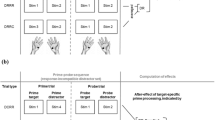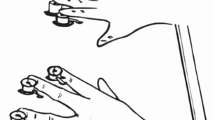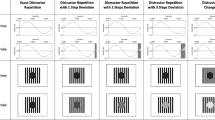Abstract
In selection tasks where target stimuli are accompanied by distractors, responses to target stimuli, target stimuli and the distractor stimuli can be encoded together as one episode in memory. Subsequent repetition of any aspect of such an episode can lead to the retrieval of the whole episode including the response. Thus, repeating a distractor can retrieve responses given to previous targets; this mechanism was labeled distractor-response binding and has been evidenced in vision and audition. Yet, previous research suggests possibly different distractor processing in the tactile as compared to the visual modality. In the present study, we therefore used a selection task in which participants always responded to one tactile stimulus while ignoring another. Evidence for the integration of tactile distractors with target responses was found in response times and errors. Our results indicate that binding of responses to distractors is a cognitive process that is independent of the stimulus’ modality.


Similar content being viewed by others
Notes
Note that an interesting feature of our experiment was that we used quite complex tactile patterns as stimuli whereas in most published experiments on tactile processing short pulses were used as stimuli (e.g., Soto-Faraco et al. 2004). Our stimuli develop over time and could be identified not earlier than about 500 ms after stimulus onset. However, participants needed on average about 1,250 ms for identifying these patterns even when they were presented without distractors in a learning phase before the experiment. Note, that the average RTs in our experiment are hence much higher as compared to the RTs in studies using simpler stimuli. Yet, the tactile patterns used here might tap tactile processing as it happens in real life, as most tactile information in real life is generally more complex than a brief pulse (e.g. a specific vibration of a cell phone).
References
Craig J (2003) The effect of hand position and pattern motion on temporal order judgments. Percept Psychophys 65:779–788
Craig J, Johnson K (2000) The two-point threshold: not a measure of tactile spatial resolution. Curr Dir Psychol Sci 9:29–32
DeYoe EA, Van Essen DC (1988) Concurrent processing streams in monkey visual cortex. Trends Neurosci 11:219–226
Dijkerman HC, de Haan EHF (2007) Somatosensory processes subserving perception and action. Behav Brain Sci 30:189–239
Drewing K, Schneider WX (2007) Disentangling functional from structural descriptions, and the coordinating role of attention. Behav Brain Sci 30:205–206
Evans P, Craig J (1991) Tactile attention and the perception of moving tactile stimuli. Percept Psychophys 49:355–364
Evans P, Craig J (1992) Response competition: a major source of interference in a tactile identification task. Percept Psychophys 51:199–206
Evans P, Craig J, Rinker M (1992) Perceptual processing of adjacent and nonadjacent tactile nontargets. Percept Psychophys 52:571–581
Fox E (1995) Negative priming from ignored distractors in visual selection: a review. Psychon Bull Rev 2:145–173
Franz VH, Fahle M, Bülthoff HH, Gegenfurtner KR (2001) Effects of visual illusions on grasping. J Exp Psychol Hum Percept Perform 27:1124–1144
Frings C (2011) On the decay of distractor-response episodes. Exp Psychol 58:125–131
Frings C, Moeller B (2010) Binding targets’ responses to distractors’ locations: distractor response bindings in a location priming task. Atten Percept Psychophys 72:2176–2183
Frings C, Rothermund K (2011) To be, or not to be…included in an event file: When are distractors integrated into S-R episodes and used for response retrieval? J Exp Psychol Learn Mem Cogn. doi:10.1037/a0023915
Frings C, Wühr P (2007) On distractor repetition benefits in the negative-priming paradigm. Vis Cogn 15:166–178
Frings C, Rothermund K, Wentura D (2007) Distractor repetitions retrieve previous responses to targets. Q J Exp Psychol 60:1367–1377
Frings C, Bader R, Spence C (2008) Selection in touch: negative priming with tactile stimuli. Percept Psychophys 70:516–523
Frings C, Amendt A, Spence C (2011) When seeing doesn’t matter: assessing the after-effects of tactile distractor processing in the blind and the sighted. J Exp Psychol Hum Percept Perform. doi:10.1037/a0022336
Giesen C, Rothermund K (2011) Affective matching moderates S-R binding. Cogn Emot 25:342–350
Goodale M, Milner A (1992) Separate visual pathways for perception and action. Trends Neurosci 15:20–25
Haggard P, Kitadono K, Press C, Taylor-Clarke M (2006) The brain’s fingers and hands. Exp Brain Res 172:94–102
Hasbroucq Y, Guiard T (1992) The effects of intensity and irrelevant location of a tactile stimulation in a choice reaction time task. Neuropsychologia 30:91–94
Hommel B (1998) Event files: evidence for automatic integration of stimulus-response episodes. Vis Cogn 5:183–216
Hommel B (2004) Event files: feature binding in and across perception and action. Trends Cogn Sci 8:494–500
Hommel B, Müsseler J, Aschersleben G, Prinz W (2001) The theory of event coding (TEC): a framework for perception and action planning. Behav Brain Sci 24:849–937
Houghton G, Tipper SP (1994) A model of inhibitory mechanisms in selective attention. In: Dagenbach D, Carr TH (eds) Inhibitory processes in attention, memory, and language. Academic Press, San Diego, CA, pp 53–112
James T, James K, Humphrey G, Goodale M (2006) Do visual and tactile object representations share the same neural substrate? In: Heller M, Ballesteros S (eds) Touch and blindness: psychology and neuroscience. Lawrence Erlbaum Associates Publishers, Mahwah, NY, pp 139–155
Kahneman D, Treisman A (1984) Changing views of attention and automaticity. In: Parasuraman R, Davies R (eds) Varieties of attention. Academic Press, Orlando, FL, pp 29–61
Kennett S, Eimer M, Spence C, Driver J (2001) Tactile-visual links in exogenous spatial attention under different postures: convergent evidence from psychophysics and ERPs. J Cogn Neurosci 13:462–478
Kennett S, Spence C, Driver J (2002) Visuo-tactile links in covert exogenous spatial attention remap across changes in unseen hand posture. Percept Psychophys 64:1083–1094
Logan GD (1988) Toward an instance theory of automatization. Psychol Rev 95:492–527
Mayr S, Buchner A (2006) Evidence for episodic retrieval of inadequate prime responses in auditory negative priming. J Exp Psychol Hum Percept Perform 32:932–943
Milner AD, Goodale MA (1995) The visual brain in action. Oxford University Press, Oxford
Mishkin M, Ungerleider LG, Macko KA (1983) Object vision and spatial vision: two cortical pathways. Trends Neurosci 6:414–417
Mondor TA, Leboe LC (2008) Stimulus and response repetition effects in the detection of sounds: evidence of obligatory retrieval and use of a prior event. Psychol Res 72:183–191
Mondor TA, Hurlburt J, Thorne L (2003) Categorizing sounds by pitch: effects of stimulus similarity and response repetition. Percept Psychophys 65:107–114
Neill WT (1997) Episodic retrieval in negative priming and repetition priming. J Exp Psychol Learn Mem Cogn 23:1291–1305
Overvliet K, Anema H, Brenner E, Dijkerman H, Smeets J (2011) Relative finger position influences whether you can localize tactile stimuli. Exp Brain Res 208:245–255
Pettypiece C, Goodale M, Culham J (2010) Integration of haptic and visual cues in perception and action revealed through cross-modal conflict. Exp Brain Res 201:863–873
Rinker M, Craig J (1994) The effect of spatial orientation on the perception of moving tactile stimuli. Percept Psychophys 56:356–362
Rock I, Harris CS (1967) Vision and touch. Sci Am 216:96–104
Rothermund K, Wentura D, De Houwer J (2005) Retrieval of incidental stimulus-response associations as a source of negative priming. J Exp Psychol Learn Mem Cogn 31:482–495
Saetti MC, De Renzi E, Comper M (1999) Tactile morphagnosia secondary to spatial deficits. Neuropsychologia 37:1087–1100
Shore D, Spry E, Spence C (2002) Confusing the mind by crossing the hands. Cogn Brain Res 14:153–163
Soto-Faraco S, Spence C, Fairbank K, Kingstone A, Hillstrom AP, Shapiro K (2002) A crossmodal attentional blink between vision and touch. Psychon Bull Rev 9:731–738
Soto-Faraco S, Ronald A, Spence C (2004) Tactile selective attention and body posture: assessing the multisensory contributions of vision and proprioception. Percept Psychophys 66:1077–1094
Spapé MM, Hommel B (2008) He said, she said: episodic retrieval induces conflict adaptation in an auditory stroop task. Psychon Bull Rev 15:1117–1121
Spence C (2010) Crossmodal spatial attention. Ann N Y Acad Sci 1191:182–200
Spence C, Pavani F, Driver J (2000) Crossmodal links between vision and touch in covert endogenous spatial attention. J Exp Psychol Hum Percept Perform 4:1298–1319
Spence C, Pavani F, Driver J (2004) Spatial constraints on visual-tactile cross-modal distractor congruency effects. Cogn Affect Behav Neurosci 4:148–169
Tipper SP (1985) The negative priming effect: inhibitory effects of ignored primes. Q J Exp Psychol 37A:571–590
Treisman A (1996) The binding problem. Curr Opin Neurobiol 6:171–178
Tukey J (1977) Exploratory data analysis. Addison-Wesley, Reading, MA
Van Dam W, Hommel B (2010) How object-specific are object files? Evidence for integration by location. J Exp Psychol Hum Percept Perform 36:1184–1192
Zmigrod S, Hommel B (2010) Temporal dynamics of unimodal and multimodal feature binding. Atten Percept Psychophys 72:142–152
Zmigrod S, Spapé M, Hommel B (2009) Intermodal event files: integrating features across vision, audition, taction, and action. Psychol Res 73:674–684
Acknowledgments
The research reported in this article was supported by a grant of the Deutsche Forschungsgemeinschaft to Christian Frings (FR 2133/1-2). We thank Charlotte Schwedes, Michaela Wanke and Manfred Neumann for conducting the experiment.
Author information
Authors and Affiliations
Corresponding author
Rights and permissions
About this article
Cite this article
Moeller, B., Frings, C. Remember the touch: tactile distractors retrieve previous responses to targets. Exp Brain Res 214, 121–130 (2011). https://doi.org/10.1007/s00221-011-2814-9
Received:
Accepted:
Published:
Issue Date:
DOI: https://doi.org/10.1007/s00221-011-2814-9




